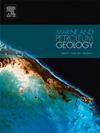Tectono-stratigraphy of the Shushan Basin, Western Desert, Egypt: A window into the evolution of the SE Mediterranean province
IF 3.7
2区 地球科学
Q1 GEOSCIENCES, MULTIDISCIPLINARY
引用次数: 0
Abstract
The SE Mediterranean is a key region documenting the geological history of the Mesozoic Tethys Ocean while comprising one of the most promising provinces in the world in terms of energy resources. Using 2D seismic reflection data tied to exploration wells, this work analyses the Shushan Basin of northern Egypt within a context dominated by continental rifting, ocean propagation, and closure of the Tethys Ocean. Nine (9) seismic megasequences and four (4) major structural trends are identified in the Shushan Basin. In the centre of the basin, the interpreted megasequences document four (4) major tectonic episodes: i) a Paleozoic early-rift stage, ii) a syn-rift stage lasting from the Early Jurassic to the Early Cretaceous, iii) an Aptian-Cenomanian post-rift stage, and iv) a syn-compressional phase that started in the Late Cretaceous and ended in the Miocene. Importantly, the data in this work suggest the presence of up to 1.6 km of Upper Paleozoic-Triassic strata below the Lower Jurassic Ras Qattara Formation. Widespread extension occurred from the Late Triassic to the Early Cretaceous, a period of time in which graben and half-graben basins were formed and delimited by E-W and NW-SE striking faults. Later in the basin's evolution, mild tectonic reactivation predominated and was accompanied by a (post-rift) thermal episode in Northern Egypt. As a corollary, we show that the tectonic episodes interpreted in this work reflect the position of the Shushan Basin near the junction between the southern margin of the Tethys Ocean, the Syrian Arc system, and the Red Sea continental rift. Consequently, regional faults interpreted in this work are grouped into four families with distinct trends: i) Red Sea, ii) Tethyan, iii) Syrian Arc, and iv) Aqaba.
埃及西部沙漠舒山盆地的构造地层学:地中海东南部省演化的一个窗口
地中海东南部是记录中生代特提斯洋地质历史的关键区域,同时也是世界上最有前途的能源资源之一。利用与探井相关的二维地震反射数据,本研究分析了埃及北部舒山盆地在大陆裂谷、海洋传播和特提斯海洋闭合的背景下的情况。在蜀山盆地共识别出9个大地震层序和4个主要构造倾向。在盆地中心,解释的巨型天然气层序记录了4个主要的构造时期:1)古生代早裂谷期,2)早侏罗世至早白垩世的同裂谷期,3)阿普提亚—塞诺曼尼亚期后裂谷期,4)晚白垩世开始至中新世结束的同挤压期。重要的是,这项工作中的数据表明,下侏罗统Ras Qattara组下存在长达1.6公里的上古生统-三叠纪地层。晚三叠世至早白垩世广泛伸展,形成地堑和半地堑盆地,并被东西向和北西-东向断裂划界。在盆地后期的演化中,温和的构造活动占主导地位,并伴随着埃及北部(裂谷后)的热事件。据此,我们认为,本研究解释的构造事件反映了蜀山盆地位于特提斯洋南缘、叙利亚弧体系和红海大陆裂谷交界处附近。因此,在这项工作中解释的区域断层被分为四个具有不同趋势的家族:i)红海,ii)特提斯,iii)叙利亚弧和iv)亚喀巴。
本文章由计算机程序翻译,如有差异,请以英文原文为准。
求助全文
约1分钟内获得全文
求助全文
来源期刊

Marine and Petroleum Geology
地学-地球科学综合
CiteScore
8.80
自引率
14.30%
发文量
475
审稿时长
63 days
期刊介绍:
Marine and Petroleum Geology is the pre-eminent international forum for the exchange of multidisciplinary concepts, interpretations and techniques for all concerned with marine and petroleum geology in industry, government and academia. Rapid bimonthly publication allows early communications of papers or short communications to the geoscience community.
Marine and Petroleum Geology is essential reading for geologists, geophysicists and explorationists in industry, government and academia working in the following areas: marine geology; basin analysis and evaluation; organic geochemistry; reserve/resource estimation; seismic stratigraphy; thermal models of basic evolution; sedimentary geology; continental margins; geophysical interpretation; structural geology/tectonics; formation evaluation techniques; well logging.
 求助内容:
求助内容: 应助结果提醒方式:
应助结果提醒方式:


